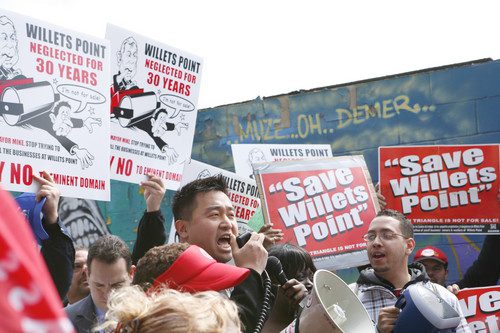The Christian Science Monitor reported a few days ago on the Bloomberg administration’s plans to redevelop the Willets Point industrial area of Queens (just east of Shea Stadium) as a mixed-income development with 5,500 units of housing and a new convention center.
The Monitor largely fell for the administration’s claims that this would be NYC’s “first green neighborhood.” But the current plans are more “emerald city” than sustainable community development.
The City’s Economic Development Corporation (EDC) intends to acquire or condemn (through eminent domain) 61 acres containing 250 privately owned industrial businesses, employing more than 1,300 workers. EDC would then issue a request for proposals for a developer to build 5,500 units of housing; 1.7 million square feet of retail, commercial, and entertainment space (including a 2,700-seat movie theater); a hotel; and convention center.
If this sounds a lot like other Bloomberg administration developments, you’ve been paying attention. The administration has rezoned thousands of blocks, eliminating nearly 70 percent of the manufacturing space in Manhattan, and more than 25 percent citywide — replacing them with condos and office buildings.
It might seem “green” to replace industrial businesses (many of which, to be sure, are auto salvage shops and don’t scream sustainability) with shiny new buildings that meet LEED standards. But is it really what New York needs? Community groups (including Queens for Affordable Housing, Queens Congregations United for Action, and ACORN), workers and businesses, and the majority of New York City Council members aren’t so sure.
Those 1,300 jobs employ blue-collar New Yorkers, mostly immigrants, mostly from Queens, many from the adjacent working-class neighborhoods of Corona, Elmhurst, and Flushing. No one would mistake the new Willets Point for a working-class neighborhood. The Bloomberg administration has made no commitment to how many of the housing units would be affordable (there have been vague indications that it would be 80 percent market-rate, 20 percent affordable, in a city where millions of low-income New Yorkers pay more than half their income for rent). No commitments to living-wage jobs for nearby residents. And no meaningful commitment to help the workers and small businesses that are there now relocate successfully.
And does it really reduce our carbon footprint to have our cars go to New Jersey to be deconstructed? Or to have ethnic food distribution points further from the NYC stores and restaurants that want them? Yes, it makes smart-growth sense to develop densely near transit. But does that mean the Bloomberg administration thinks sustainability is an argument for replacing all of city’s manufacturing jobs with luxury condos with green roofs?
If we decide as a city that it does make sense to redevelop Willets Point — to take advantage of good transit connections (to the LIRR and the subway), proximity to Shea Stadium and the Flushing River (now badly polluted, and with no plans for cleanup despite the green marketing of the Willets Point plan) — then the current plans need to be dramatically altered to better meet the needs of workers, residents, business owners, and nearby communities. Over the past year, the Pratt Center for Community Development has worked with local community organizations, unions, and hundreds of community residents to prepare a report on community priorities for Willets Point.. If redevelopment is going to proceed, they said, it must:
- Do right by existing businesses and workers, with fair compensation, and genuine relocation and retraining/placement accessible to all.
- Make most of the housing affordable to a wide range of low/moderate/middle-income families.
- Guarantee that new jobs are living/prevailing wage, and targeted to local residents and current workers.
- Provide the necessary physical and social infrastructure.
- Respect and connect to surrounding neighborhoods (especially Corona, East Elmhurst, and Flushing), and clean up the Flushing River as part of the plan.
Despite concerns expressed by a majority of City Council members, the Bloomberg administration decided to press forward with its proposal, beginning the official land-use process in April. Over the next six months, the local community board, Queens borough president, City Planning Commission, and City Council will all review the plan. Will it pass more-or-less as is? Will it be improved to meet the communities’ goals? Or will it be rejected, allowing current business owners and workers to remain?
If the experience of most Bloomberg administration rezonings is repeated, it will get a little better (with a somewhat higher percentage of affordable units, and some commitments to labor for union jobs), but stay fairly close to its original version. But with the economy declining, the Bloomberg administration beginning to near its completion in 2009, and the unprecedented early concern of a majority of the City Council, this one might be different.
As for achieving green neighborhoods, the answer is not wiping out industrial areas and building new emerald cities. Most of the carbon footprint of NYC’s neighborhoods is from existing buildings, built over the past century.
Rather than focus so much on new construction, let’s invest more in retrofitting current buildings (creating living-wage, green-collar jobs at the same time), educate New Yorkers about how they can save energy and reduce waste, and do more to make green neighborhoods out of the ones we already have.






Comments